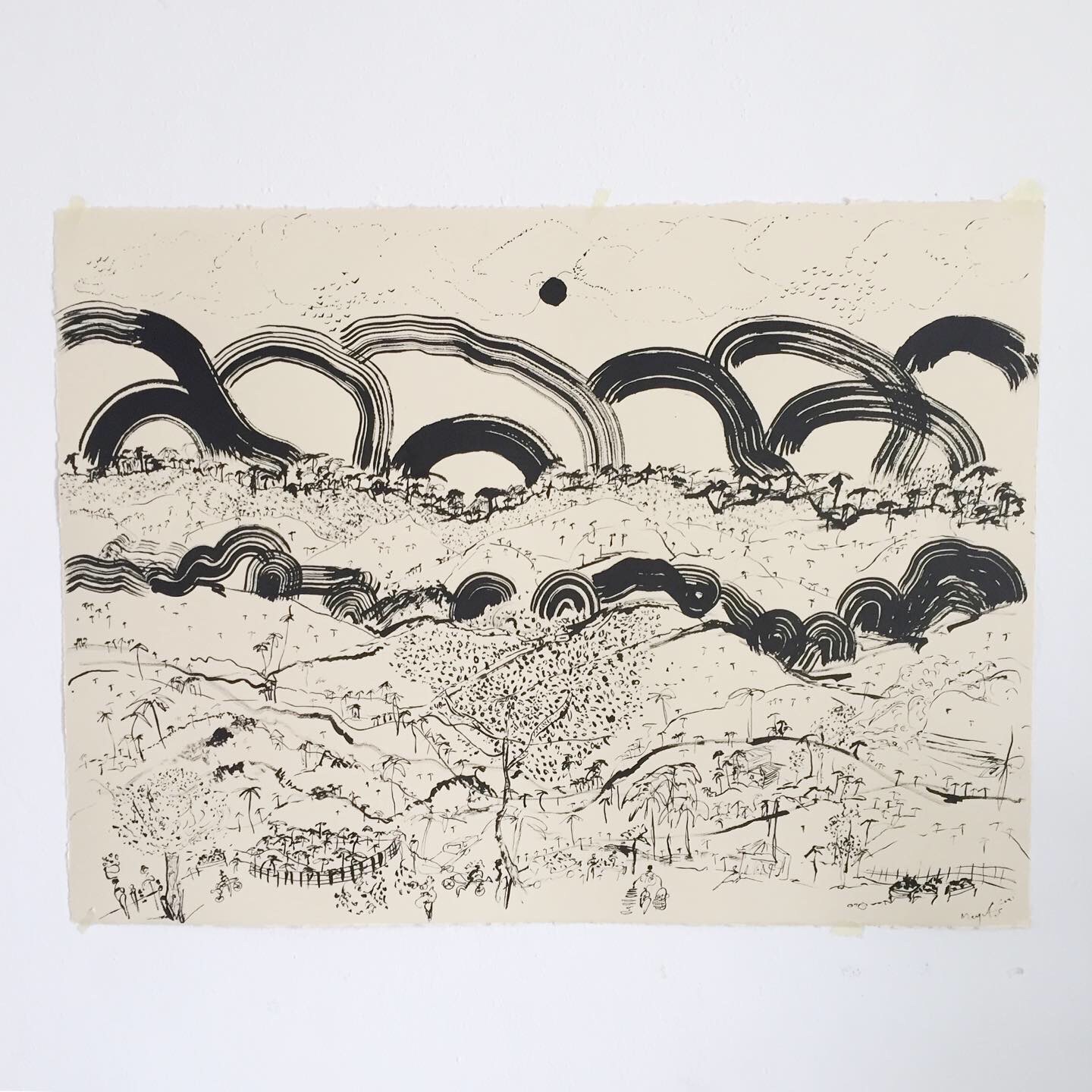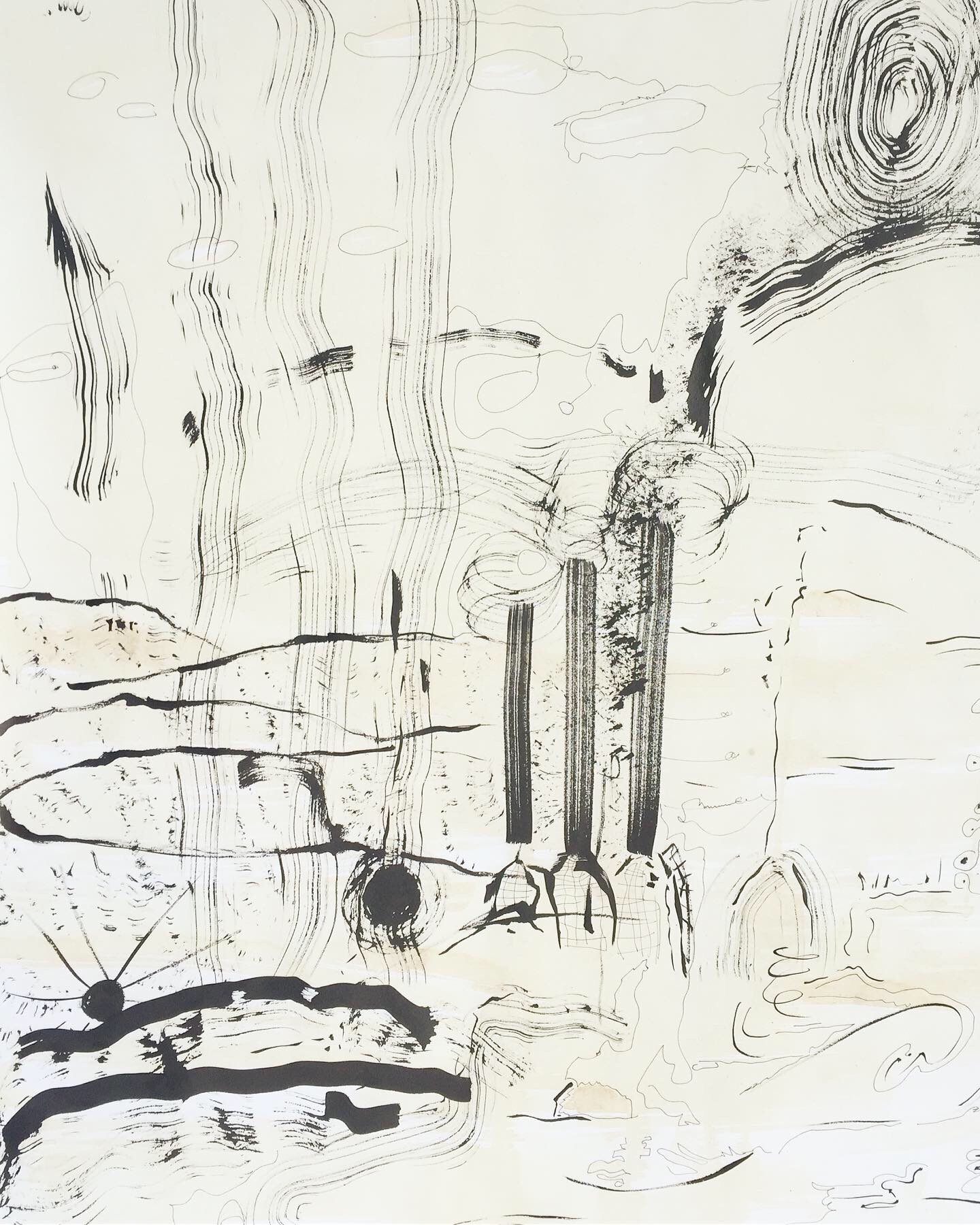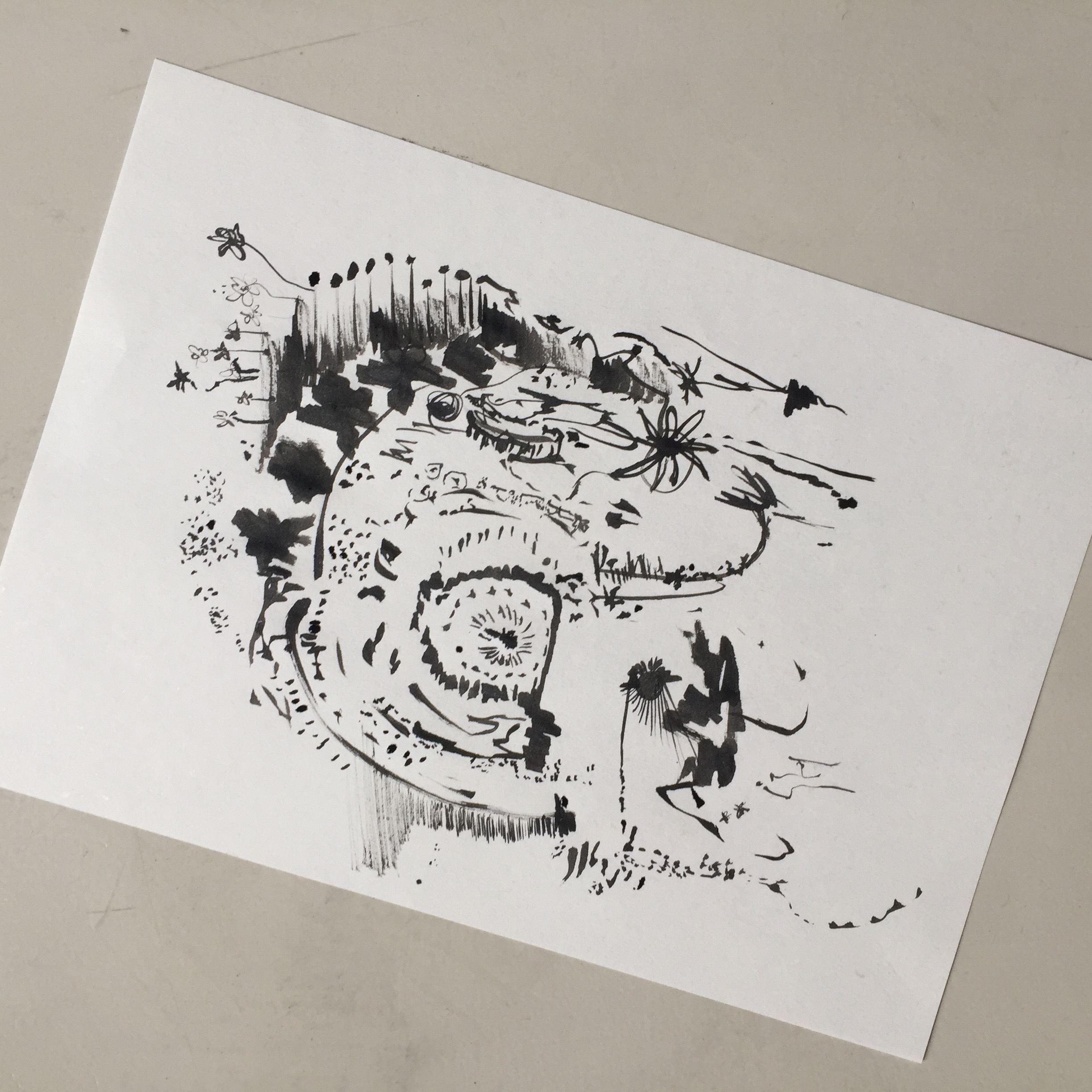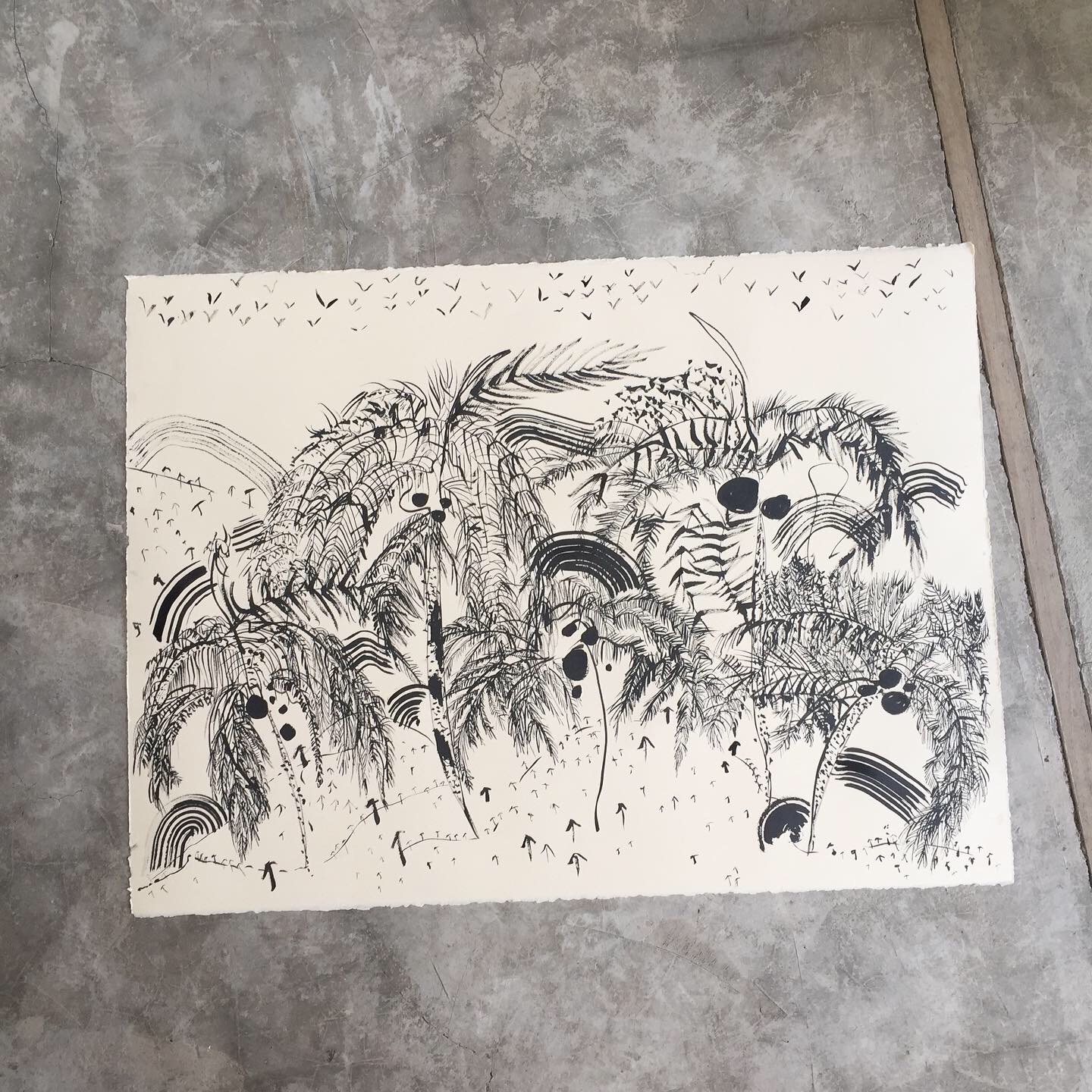In Conversation with
Mayte Nicole
In Conversation with
Mayte Nicole
We spoke to the incredibly talented multidisciplinary artist about her work, her creative process, her inspirations and her journey and trajectory as an artist and creative.

A couple months ago I was scrolling through Instagram when I stumbled upon a post that really caught my eye. It was a picture of a black ink drawing on an A4-sized piece of paper. I clicked on the artist’s profile and was met with a barrage of drawings, all black ink, all on paper. After looking through several pieces, I was hooked. More than hooked, however, I was intrigued. The combination of soft, delicate strokes and bold, in-your-face lines of jet-black ink just had something to it that I couldn’t quite put my finger on. As time passed and more drawings started appearing on the artist’s feed, I noticed that there was a certain fluidity, a certain intuitiveness in the way the pieces were drawn that was appealing on a visceral level. Little did I know, all these traits weren’t just part of the artwork; they were an essential part of the artist herself.
“Desayuno con Omar”
on coffee-dyed paper
on coffee-dyed paper
Mayte Nicole (@maytenicoleesteban) is a multidisciplinary artist from the Dominican Republic. Throughout the last few years, Mayte has relished in elusiveness, focusing on herself and her personal and artistic growth while nurturing her talents and her interests in search of a medium that truly resonated with her. Mayte began her studies in interior design, but shortly before graduating she realized that there was something lacking in her connection to the craft. It was this realization that led her to a multi-year search for a medium that she genuinely connected with. This search took her all the way to Buenos Aires, Argentina, where she took a 3-month carpentry course with carpenter Gonzalo Arbutti (@gonzaloarbuttilaboratori).
After living in Buenos Aires for a little over a year, and a stint in knitting and carpentry in the meantime, Mayte moved to Barcelona in order to follow a blooming interest in pottery. In Barcelona, Mayte gained a lot of insight into the creative industry while assisting creative Guillermo Santoma (@sguillermos), who specializes in design, architecture, sculpture and scenography. Other than Santoma, she was constantly surrounded by a tight-knit community of artists and creatives, all of whom inspired her in one way or another. Mayte spent some time developing her newfound passion for pottery and working with these creatives in order to continue her search for a medium, but she still yearned for a certain fulfillment that her work just didn’t give her. While still on this search, she eventually found herself housesitting a friend’s apartment. Surrounded by materials that her friend had laying around, she decided to give the black ink and paper a try. Before long, her drawings had become her outlet. The intuitiveness I’d first felt in her drawings stems from her process, which looks to instinctively represent a certain emotional reaction to whatever experience she feels like revisiting.

“Desde la Guagua”
After talking to Mayte, the black ink and the paper suddenly made so much sense. In Buenos Aires, under Arbutti’s tutelage, Mayte developed an interest in Japanese methods of construction and assembling. This interest eventually grew and became a rigorous exploration of Japanese culture itself, and the roots behind the methodology they applied in their work. Mayte’s technique bears a lot in common with traditional Japanese drawings and calligraphy, both in the materials and the subtle strokes used in the application. The materials Mayte uses also have a more intrinsic use, since their straightforwardness allows her to focus purely on whatever she is trying to convey in her work.
Mayte’s art is a beautiful display of what it’s like to translate feelings and emotions to a graphic format. Throughout her work, both in her more abstract pieces and in her landscapes, a sense of rawness permeates. The immediacy and spontaneity of her work is what manages to transmit the abstract ideas that she wishes to portray. To me, perhaps the most interesting thing is how the fluidity in her pieces perfectly encapsulates her ethos as an artist. Her exploration of meaning and expression is present in her body of work, as the work itself has become a core part her process to find herself. Most of Mayte’s drawings are open to interpretation, but that’s the true beauty of her work. Where I may see one thing, you may see something else, but the visceral connection between the audience, the artist and the art is always present.

“Last Night the Moon Came to Me”
First off, tell me a little bit about how you first got interested in art and creative expression. Was this something that was always present in your life from a young age or is it something that developed later in life as you got older?
I was always a creative child; my mother saw that too and enrolled me in every art class she could find. I took painting lessons in Guillo Perez’s little art school when i was a kid, danced in the academy Ritmos for 5 years when I was a teenager, and was constantly exposed to culture- theatre, movies, exhibitions… That and traveling every weekend to the countryside and just being in nature was probably the biggest teacher of them all- having this kind of childhood gave me the space to feel free in my expression, and safe in my environment, 2 things I think are very important to develop your creativity.
“Traveling every
weekend to the countryside and
just being in nature was probably the biggest teacher
of them all- having this kind of
childhood gave me the space to feel free in my expression.”
![]()
just being in nature was probably the biggest teacher
of them all- having this kind of
childhood gave me the space to feel free in my expression.”

“Ya en la Ciudad 01”
You spent quite some time in Buenos Aires and
Barcelona learning from incredibly talented creatives from different
disciplines. I imagine that some, if not all of them, have somehow affected the
way you approach your work. If so, can you elaborate a little on what your time
learning from these creatives taught you about your own approach to art and
creativity? In Buenos Aires I first touched clay with a ceramist named Natalia Roger (@nataliarogerceramicas). There, I built a very beautiful friendship with it. Ceramics represent to me a very important tool in my path, saving me from the emptiness of not knowing what to do and letting me shape those creative voids. I don’t think I’ve ever thought of it as something I would dedicate my life to, but it has taught a lot and helped loads. It has also helped me support myself financially.
2 weeks after I first moved to Barcelona, I met Guillermo Santoma through some friends in common. He told me I could help him with the architectural models of a couple of projects he had going on in his studio. We then got super drunk, and the next morning I went (with the biggest hangover ever) straight to his workspace, where I learned another way of creating. It was very inspiring and led me to break up with interior design as a career. I think being next to someone who deconstructed everything in his creative process made me think about my own and that’s when my path to drawing started paving itself.
I’ve met incredible artists of all disciplines throughout my life, everywhere I’ve lived. All of them inspire me every day to create and expand my consciousness in art. Having these people as mirrors is very important in finding myself and my own voice. I’m still doing that- it’s a process that will, hopefully, never stop.
“Having these people as
mirrors is very important
in finding myself and my own voice. I’m still doing
that- it’s a process that will, hopefully, never stop.”
Personally, I feel that my setting heavily
affects my own creative work. Whatever culture I’m surrounded by always manages
to somehow creep into my work. In terms of your work, I know that drawing was
something that you adopted while in Barcelona, a city that is known for its
creative energy and its deeply ingrained art scene. After living in Santo
Domingo, Buenos Aires, and Barcelona, have you noticed any difference in your
creative output or inspiration depending on which city you are in at the time
and the people you interact with while in that specific city? in finding myself and my own voice. I’m still doing
that- it’s a process that will, hopefully, never stop.”
My relationship with paper and ink is very new and it’s the first time I travel and still use the same format to express myself creatively. Before it, I was in a constant search of exactly this. It’s the closest feeling I’ve had of wanting to get married. I want to marry paper and ink.
What I draw in it comes accordingly to the city I’m in and its own energy. I try to adapt my strokes to it, listen and watch and then translate in my own visual language whatever I receive. Even though there are different parts of myself that come, or not, out in every city… It’s always the same person, the vessel is the same, I just change the water and flowers.
“Even
though there are different parts of myself
that come, or not, out in every city… It’s always the
same person, the vessel is the same, I just
change the water and flowers.”
that come, or not, out in every city… It’s always the
same person, the vessel is the same, I just
change the water and flowers.”
When we first spoke, you mentioned that spirituality plays a big role in your work and your approach to art. Could you tell me a little bit about your first explorations into spirituality, and where your interest in it stems from?
I’m Dominican, therefore I’ve been surrounded by spirituality- the most common to us all is under the umbrella of Catholicism. At age 6, I attended a catholic school and did not feel attracted to church at all. It didn’t fill my void or answer my existential questions. On the contrary, it made me really angry.
My mother is a spiritual potpourri, she’s into everything and nothing at all. We never went to church, but she respects rituals and temples. This either helped or made it more complicated for me, but it definitely gave me space to find my own vision.
The process has been long, hard, dark, and confusing but it’s very gratifying. I don’t want to preach what I understand is true, but allowing myself to search for bigger answers has helped me a lot creatively and in my understanding of humanity. It has also helped my exploration into natural cycles; life and death, light and dark, duality and unity, the pleasure and pain of emptiness; all of this is what’s behind my drawings. It's the base of my inspiration and it’s how I see life.
“I don’t want to preach what I understand is
true,
but allowing myself to search for bigger
answers has helped me a lot creatively and in
my understanding of humanity.”
but allowing myself to search for bigger
answers has helped me a lot creatively and in
my understanding of humanity.”

“Untitled”
Initially, I was only attracted to their aesthetics. There was no profound reason at first, but then I started discovering that my connection to paper and ink led into a deeper meaning and manifested a direct connection to Zen Buddhist philosophy. The symbols that are common in sumi-e (Ink Wash Painting) are symbols I intuitively drew when I first touched ink with an artistic intention. It’s been very magical to see this because it gives meaning to everything I’m trying to vibrate to in a spiritual level. I say “trying” because it’s so hard! And I recognize that I know nothing, I feel like a baby, but connecting one thing to the other helps keep myself on track and keeps me interested and committed to it.
“The symbols that are
common in sumi-e
(Ink Wash Painting)
are symbols I intuitively drew
when I first touched ink with an artistic intention.”
“It’s been very magical to see this because
it gives meaning to everything I’m trying to vibrate to in a spiritual level.”
(Ink Wash Painting)
are symbols I intuitively drew
when I first touched ink with an artistic intention.”
“It’s been very magical to see this because
it gives meaning to everything I’m trying to vibrate to in a spiritual level.”
Throughout your career, you’ve explored several different disciplines, ranging from interior design and carpentry to knitting, pottery and eventually your current work in drawings, among other things. After going through all these stages and familiarizing yourself with several disciplines, what do you think made you gravitate towards drawing in particular?
Maybe the immediacy of it. It’s a direct conversation, like writing; instant gratification. I love that. Before, everything I did took a lot of time and technique to finally show itself. I think I’m done with that, at least for now.
“Maybe the immediacy of it. It’s a direct
conversation, like writing; instant gratification.”
conversation, like writing; instant gratification.”

“Llovizna Azul”
I use black because it gives me the space, in a very elegant way, to change styles and languages while having the same conversation (in this case drawing). I feel it is safe to let myself explore between super-charged drawings and very simple ones if it's all in the same tone. Also, I think I have a very colorful, very Dominican personality. Black is my attempt to find balance and it allows me to fill, with a lot of emotion, what I visually see and try to tell.
Paper is so delicate, that’s why I like it. It makes me feel safe and drawn to it. This also helps in balancing the aggressiveness and boldness of some of my drawings.
“I think I have a very colorful,
very Dominican personality.
Black is my attempt to find balance and it allows me
to fill, with a lot of emotion, what I visually see and try to tell.”
Black is my attempt to find balance and it allows me
to fill, with a lot of emotion, what I visually see and try to tell.”
 Mayte during an impromptu showing
Mayte during an impromptu showingat Santo Domingo’s Calle el Conde
I love to draw flowers, but it's empty in emotion, and it's actually a joke I like to tell myself that I'm trying to make a piece out of the biggest and most perfect artwork, which is nature. What inspires me the most is people, and how we relate to it, to nature; how clumsy we are towards it. That includes emotions. That’s when it really hit me; it’s the combination. I can’t see one thing separated from the other. The dance between both is what inspires me the most.
“What inspires me the most is
people, and how we
relate to it, to nature; how clumsy we are towards it. That includes emotions.
That’s when it really hit me; it’s the combination.
I can’t see one thing separated from the other.”
relate to it, to nature; how clumsy we are towards it. That includes emotions.
That’s when it really hit me; it’s the combination.
I can’t see one thing separated from the other.”

“Palmeras”
Adrià Cañameras, a Catalan photographer.
Also, Harold Budd’s 1978 album, The Pavilion of Dreams.
Both are so inspiring and always transmit a lot of peace.

2008 photograph by Adrià Cañameras
We’d like to give a special thanks to Mayte for taking the
time to talk to us and answer our questions. For more
on her and her work, be sure to check out
her Instagram and keep an
eye out for her future work.